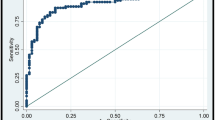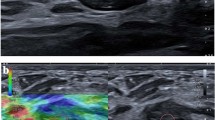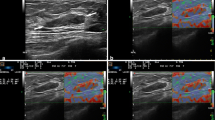Abstract
Elastography (ES) is a technique that, when associated with traditional B mode ultrasound (US), allows the degree of elasticity of tissue to be evaluated according to a color scale system. The aims of the study were to compare the diagnostic characteristics of two widely used techniques adopted in breast cancer screening; US and color Doppler (CD), with those of the same two techniques plus ES, and assessment of the same diagnostic characteristics when the three methods were applied to lesions < or >1 cm. Methods used included subjecting 212 women to investigations aimed at the early diagnosis of breast cancer outside the screening model, whereby 395 lesions were detected by US, ES, and CD, with a definitive diagnosis proved by histological exam. The diagnostic performance of US, ES, CD, and their combinations was calculated. The results showed that comparing the diagnostic characteristics of the three methods with reference to the definitive histological results for malignant breast lesions, the best diagnostic accuracy was obtained when US, ES, and CD were combined (0.837). For lesions <1 cm, diagnostic accuracy was 0.782, and for those >1 cm, it was 0.886. In the lesions <1 cm, which were more difficult to study, a positive ES score (>4) appeared to be sufficient to deepen the diagnosis, even though 35 % of the ES or US positive lesions were not malignant. By contrast, in lesions >1 cm, the probability of having a malignant lesion when all three tests were positive was very high (97 %). It was concluded that early diagnosis is a key factor in breast cancer, so an economically sustainable, non-invasive pathway is the target of diagnostic breast imaging.
Riassunto
L’elastosonografia (ES) è una metodica che associata all’ecografia consente di valutare l’elasticità e rigidità dei tessuti utilizzando una scala cromatica. Obiettivi di questo studio sono: confrontare le caratteristiche diagnostiche dell’ecografia (US) e del doppler (CD), due metodiche utilizzate per la diagnosi di tumore al seno, con quelle dell’ES, da sola o in combinazione con le precedenti; valutare le stesse caratteristiche in lesioni < o >1cm. Metodi: 212 donne sono state sottoposte a valutazione per diagnosi precoce di tumore al seno, al di fuori di un programma di screening. 395 lesioni sono state studiate con US, ES, e CD e la diagnosi definitiva è risultata dall’esame istologico. E’ stata misurata la performance diagnostica delle 3 metodiche e delle loro combinazioni. Risultati: Dalla comparazione delle diverse metodiche emerge che la più elevata accuratezza diagnostica, per individuare lesioni maligne della mammella, si ottiene utilizzando le 3 metodiche congiuntamente (0.837). Per lesioni <1cm l’accuratezza diagnostica è 0.782, e per quelle >1cm 0.886. Nelle lesioni <1cm, le più complesse da valutare, un punteggio ES>4 sembra essere sufficiente per approfondire l’iter diagnostico, sebbene il 35% delle lesioni positive all’ES o all’US siano di tipo benigno. Diversamente, nelle lesioni >1cm la probabilità di avere una lesione maligna quando tutte e tre le metodiche sono positive è risultata molto alta (97%). Conclusioni. La diagnosi precoce rappresenta un fattore chiave nel carcinoma mammario; pertanto, un percorso economicamente sostenibile, e non invasivo è il target dell’imaging diagnostico per la mammella.



Similar content being viewed by others
References
Oyama T, Koibuchi Y, McKee G (2004) Core needle biopsy (CNB) as a diagnostic method for breast lesions: comparison with fine needle aspiration cytology (FNA). Breast Cancer 11:339–342
Ayata G, Abu-Jawdeh GM, Fraser JL, Garcia LW, Upton MP, Wang HH (2003) Accuracy and consistency in application of a probabilistic approach to reporting breast fine needle aspiration. Acta Cytol 47:973–978
Wallis M, Tardivon A, Helbich T, Schreer I (2007) Guidelines from the European society for breast imaging for diagnostic interventional breast procedure. Eur Radiol 17:581–588
Brunner AH, Sagmeister T, Kremer J, Riss P, Brustmann H (2009) The accuracy of frozen section analysis in ultrasound-guided core needle biopsy of breast lesions. BMC Cancer 9:341
Goddi A, Bonardi M, Alessi S (2012) Breast elastography: a literature review. J Ultrasound 15:192–198
Burnside ES, Hall TJ, Sommer AM et al (2007) Differentiating benign from malignant solid breast masses with US strain imaging. Radiology 245:401–410
Landoni V, Francione V, Marzi S et al (2012) Quantitative analysis of elastography images in the detection of breast cancer. Eur Radiol 81:1527–1531
Scaperrotta G, Ferranti C, Costa C et al (2008) Role of sonoelastography in non-palpable breast lesions. Eur Radiol 18:2381–2389
Thitaikumar A, Mobbs LM, Kraemer-Chant CM, Garra BS, Ophir J (2008) Breast tumor classification using axial shear strain elastography: a feasibility study. Phys Med Biol 53:4809–4823
Kj Parker, MM Doyle, DJ Rubens (2011) Imaging the elastic properties of tissue: the 20 year perspective. Phys Med Biol 56:R1–29
Itoh A, Ueno E, Tohno E et al (2006) Breast disease: clinical application of US elastography for diagnosis. Radiology 239:341–350
Rizzato G, Aiani L, Baldassarre S, Bulzacko A, Della Sala S, Locatelli M et al (2006) Characterization of breast lesions with realtime sonoelastography: results from an Italian multicenter clinical trial. Abstract-RSNA, Chicago
Giuseppetti GM, Martegani A, Di Cioccio B, Baldassarre S (2005) Elastography in the diagnosis of the nodular breast lesions: preliminary report. Radiol Med 110:69–77
Barr RG (2012) Sonographic breast elastography: a primer. J Ultrasound Med 31:773–783
Barr RG, Destounis S, Lackey LB, Svensson WE, Balleyguier C, Smith C (2012) Evaluation of breast lesions using elasticity imaging: a multicenter trial. J Ultrasound Med 31:281–287
Barr RG (2010) Real-time ultrasound elasticity of the breast: initial clinical results. Ultrasound Q 26:61–66
Taylor K, O’Keeffe S, Britton PD, Wallis MG, Treece GM, Housden J, Parashar D, Bond S, Sinnatamby R (2011) Ultrasound elastography as an adjuvant to conventional ultrasound in the preoperative assessment of axillary lymph nodes in suspected breast cancer: a pilot study. Clin Radiol 66:1064–1071. doi:10.1016/j.crad.2011.05.015
Zhou J, Zhan W, Dong Y, Yang Z, Zhou C (2014) Stiffness of the surrounding tissue of breast lesions evaluated by ultrasound elastography. Eur Radiol 24:1659–1667. doi:10.1007/s00330-014-3152-7
Baum JK, Hanna LG, Acharyya S, Mahoney MC, Conant EF, Bassett LW, Pisano ED (2011) Use of BI-RADS 3-probably benign category in the American College of Radiology imaging network digital mammographic imaging screening trial. Radiology 260:61–67
Author information
Authors and Affiliations
Corresponding author
Ethics declarations
Conflict of interest
The authors have no conflict of interest for this study.
Ethical statement
The study was conducted in accordance with the Declaration of Helsinki.
Informed consent
A written informed consent was obtained from all participants.
Rights and permissions
About this article
Cite this article
Botticelli, A., Mazzotti, E., Di Stefano, D. et al. Positive impact of elastography in breast cancer diagnosis: an institutional experience. J Ultrasound 18, 321–327 (2015). https://doi.org/10.1007/s40477-015-0177-y
Received:
Accepted:
Published:
Issue Date:
DOI: https://doi.org/10.1007/s40477-015-0177-y




